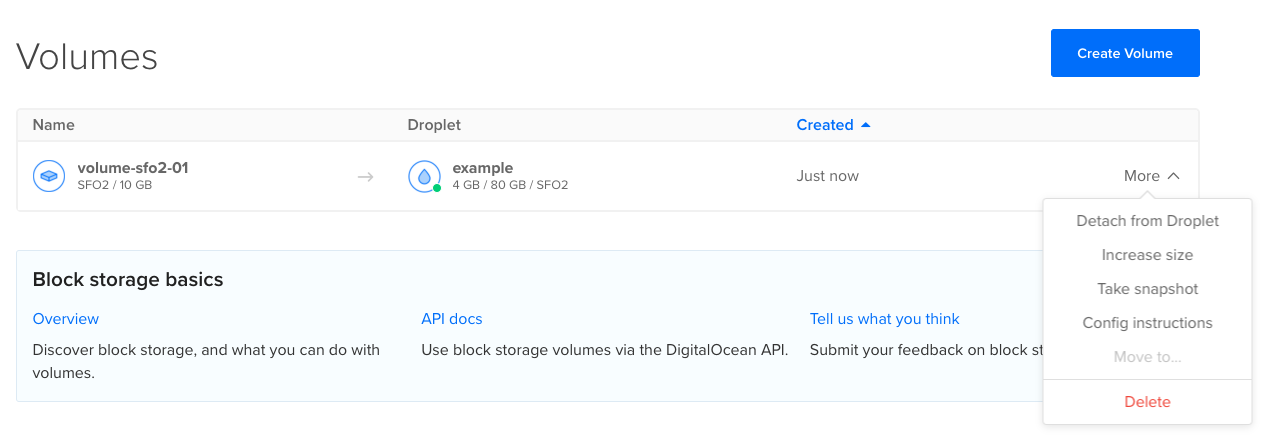To remove a volume from a Droplet, you can either detach the volume or delete the volume.
- Detaching a volume removes the volume from its current Droplet. You can attach the volume and all of its contents to a different Droplet as needed.
- Deleting a volume permanently destroys the volume and its contents. This action cannot be reversed.
Detach a Volume Using Automation
Before detaching a volume, unmount it to avoid data loss.
How to Detach a Volume Using the DigitalOcean CLI
- Install
doctl, the official DigitalOcean CLI.
- Create a personal access token and save it for use with
doctl.
- Use the token to grant
doctl access to your DigitalOcean account.
- Finally, run
doctl compute volume-action detach. Basic usage looks like this, but you can read the usage docs for more details:
doctl compute volume-action detach <volume-id> <droplet-id> [flags]
f81d4fae-7dec-11d0-a765-00a0c91e6bf6 from a Droplet with the ID 386734086:
doctl compute volume-action detach f81d4fae-7dec-11d0-a765-00a0c91e6bf6 386734086
To detach a volume using the API, use the volume actions endpoints and set the type field to detach.
How to Detach a Volume Using the DigitalOcean API
- Create a personal access token and save it for use with the API.
- Send a POST request to
https://api.digitalocean.com/v2/volumes/{volume_id}/actions.
cURL
Using cURL:
# Attach a Volume to a Droplet by ID
curl -X POST \
-H "Content-Type: application/json" \
-H "Authorization: Bearer $DIGITALOCEAN_TOKEN" \
-d '{"type": "attach", "droplet_id": 11612190, "region": "nyc1", "tags":["aninterestingtag"]}' \
"https://api.digitalocean.com/v2/volumes/7724db7c-e098-11e5-b522-000f53304e51/actions"
# Remove a Volume from a Droplet by ID
curl -X POST \
-H "Content-Type: application/json" \
-H "Authorization: Bearer $DIGITALOCEAN_TOKEN" \
-d '{"type": "detach", "droplet_id": "11612190", "region": "nyc1"}' \
"https://api.digitalocean.com/v2/volumes/7724db7c-e098-11e5-b522-000f53304e51/actions"
# Resize a Volume
curl -X POST \
-H "Content-Type: application/json" \
-H "Authorization: Bearer $DIGITALOCEAN_TOKEN" \
-d '{"type":"resize","size_gigabytes": 100, "region":"nyc1"}' \
"https://api.digitalocean.com/v2/volumes/7724db7c-e098-11e5-b522-000f53304e51/actions"
Go
Using Godo, the official DigitalOcean API client for Go:
import (
"context"
"os"
"github.com/digitalocean/godo"
)
func main() {
token := os.Getenv("DIGITALOCEAN_TOKEN")
client := godo.NewFromToken(token)
ctx := context.TODO()
// Attach a Volume to a Droplet by ID
action, _, err := client.StorageActions.Attach(ctx, "7724db7c-e098-11e5-b522-000f53304e51", 11612190)
// Remove a Volume from a Droplet by ID
// action, _, err := client.StorageActions.Detach(ctx, "7724db7c-e098-11e5-b522-000f53304e51")
// Resize a Volume
// action, _, err := client.StorageActions.Resize(ctx, "7724db7c-e098-11e5-b522-000f53304e51", 100, "nyc1")
}
Ruby
Using DropletKit, the official DigitalOcean API client for Ruby:
require 'droplet_kit'
token = ENV['DIGITALOCEAN_TOKEN']
client = DropletKit::Client.new(access_token: token)
# Attach a Volume to a Droplet by ID
client.volume_actions.attach(volume_id:'7724db7c-e098-11e5-b522-000f53304e51', droplet_id: 11612190, region: 'nyc1'
# Remove a Volume from a Droplet by ID
# client.volume_actions.detach(volume_id:'7724db7c-e098-11e5-b522-000f53304e51', droplet_id: 11612190, region: 'nyc1'
Python
Using PyDo, the official DigitalOcean API client for Python:
import os
from pydo import Client
client = Client(token=os.environ.get("DIGITALOCEAN_TOKEN"))
req = {
"type": "attach",
"droplet_id": 11612190,
"region": "nyc1",
"tags": [
"aninterestingtag"
]
}
resp = client.volume_actions.post_by_id(volume_id="7724db7c", body=req)
Detach a Volume Using the Control Panel
Before detaching a volume, unmount it to avoid data loss.
You can detach a volume from the volume’s More menu, which is available on the account-level Volumes page.

Select Detach from Droplet to detach the volume. You can then attach the volume to a different Droplet as needed.
If you detach an auto-mounted volume, you should also delete the corresponding systemd config file from the Droplet, which is at /etc/systemd/system/mnt-volume_*.mount.
